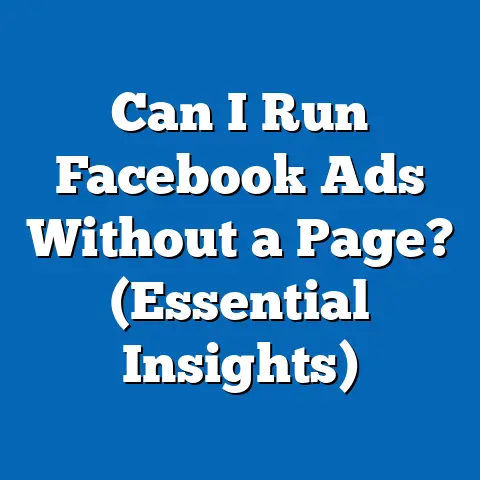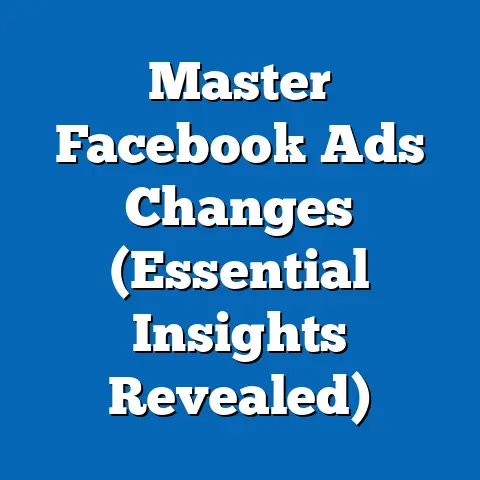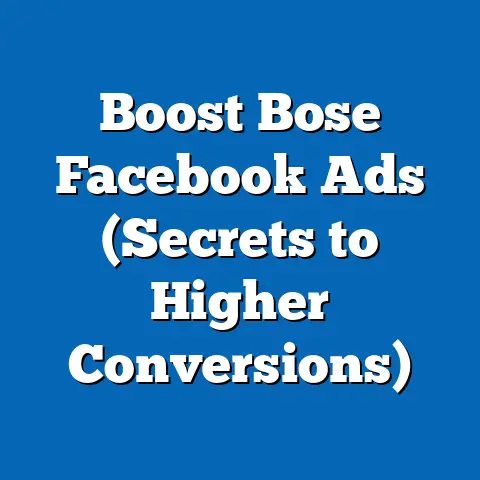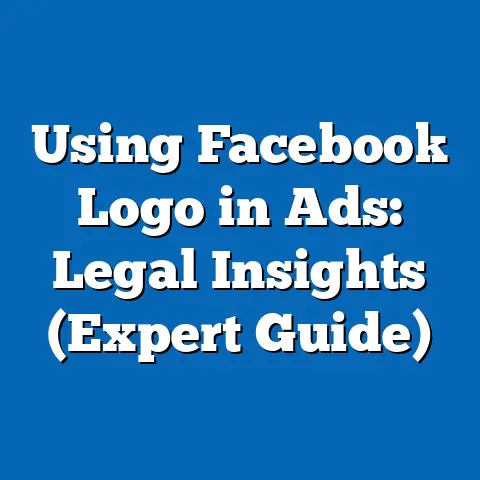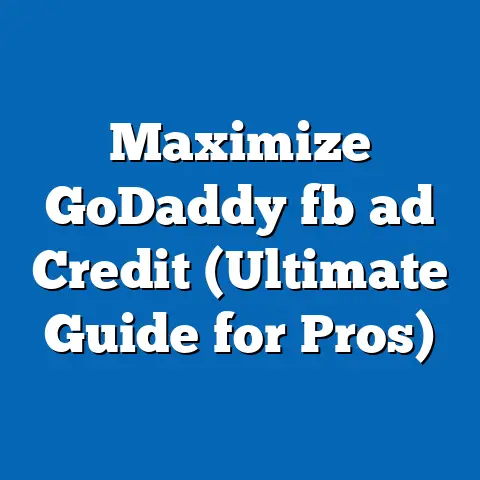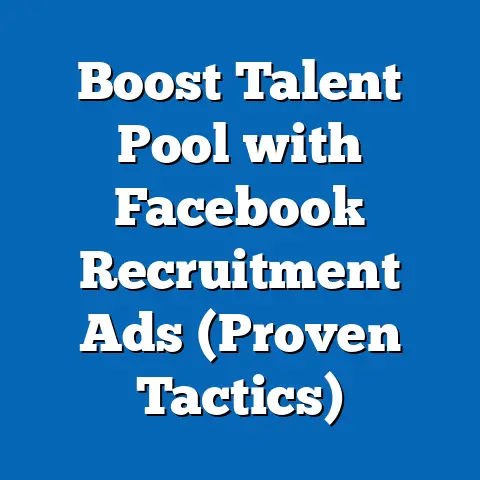Master Facebook Ads Terms (Unlock Campaign Success)
In today’s digital age, hobbies are more than just pastimes—they are powerful lenses through which we can understand consumer behavior and craft targeted marketing strategies. Whether it’s gardening, gaming, or fitness, hobbies shape how individuals spend their time and money, making them a goldmine for advertisers on platforms like Facebook. According to a 2022 Statista survey, 77% of U.S. adults engage in at least one hobby regularly, with popular categories including outdoor activities (34%), creative arts (29%), and technology-related interests (22%).
These statistics highlight the vast potential for businesses to connect with niche audiences through tailored advertising. Facebook, now part of Meta, remains a dominant force in digital advertising, with over 2.9 billion monthly active users worldwide as of 2023 (Meta Investor Reports). With such a massive and diverse user base, mastering Facebook Ads is critical for brands looking to tap into specific hobbyist communities and drive campaign success.
Section 1: The Landscape of Hobbies and Digital Advertising
Why Hobbies Matter in Marketing
Hobbies are not just personal interests—they’re a reflection of identity, values, and spending habits. A 2021 report by the National Endowment for the Arts found that Americans spend an average of $1,200 annually on hobby-related purchases, with younger adults (ages 18-34) spending the most at $1,500 per year. This spending power makes hobbyists a lucrative target for advertisers.
On platforms like Facebook, hobbies serve as a key segmentation tool. Marketers can target users based on their expressed interests, such as “yoga enthusiasts” or “video gamers,” allowing for hyper-specific campaigns. For instance, eMarketer reported in 2022 that interest-based targeting on social media platforms increases ad engagement rates by 25% compared to broad demographic targeting.
Demographic Breakdown of Hobbyists
Demographic differences play a significant role in hobby preferences and, by extension, advertising strategies. According to Statista’s 2022 data, women are more likely to engage in creative hobbies like crafting (42% of female respondents) compared to men (18%). Conversely, men dominate in technology and gaming hobbies, with 38% participating compared to 19% of women.
Age also influences hobby trends. Millennials (ages 27-42 in 2023) show a strong preference for fitness-related hobbies, with 45% engaging in activities like running or gym workouts, per a 2023 Pew Research Center survey. Meanwhile, Gen Z (ages 11-26) leans toward digital hobbies, with 60% spending time on gaming or content creation, reflecting their tech-savvy nature.
Historical Trends in Hobby-Based Marketing
Historically, hobby-based marketing was limited to niche magazines or local events, but the rise of social media has transformed the landscape. In 2010, only 12% of U.S. businesses used social media for targeted advertising, per a study by the American Marketing Association. By 2023, that figure had soared to 88%, with platforms like Facebook leading the charge due to their robust ad tools.
This shift underscores the growing importance of digital platforms in reaching hobbyist audiences. Today, businesses can leverage Facebook Ads to not only target specific interests but also track real-time engagement, a capability unimaginable two decades ago. The evolution of ad technology has made precision targeting accessible to even the smallest brands.
Section 2: Key Facebook Ads Terms to Master
To unlock the full potential of Facebook Ads, marketers must familiarize themselves with the platform’s terminology and tools. Below, we break down the most critical terms, using the context of hobby-based campaigns to illustrate their application. All data and definitions are sourced from Meta’s official documentation and industry reports like those from Hootsuite and Social Media Examiner.
1. Audience Targeting
Audience targeting is the foundation of any successful Facebook Ads campaign. It allows advertisers to define who sees their ads based on demographics, interests, behaviors, and more. For example, a company selling gardening tools can target users who have liked pages related to “organic gardening” or “home improvement.”
According to Meta’s 2023 Advertising Insights, campaigns using detailed interest targeting achieve a 30% higher click-through rate (CTR) compared to generic campaigns. Within hobbies, targeting sub-niches (e.g., “succulent gardening” rather than just “gardening”) can further boost relevance and engagement by up to 18%, per a 2022 Social Media Examiner report.
2. Custom Audiences
Custom Audiences enable advertisers to retarget users who have previously interacted with their brand, such as website visitors or past customers. For a hobby-focused campaign, a fitness apparel brand could upload a list of email addresses from customers who purchased yoga mats and target them with ads for complementary products like leggings.
Meta reports that Custom Audience campaigns have a 40% higher conversion rate compared to cold audience campaigns. This makes them especially effective for hobbyist markets where repeat purchases (e.g., art supplies or gaming gear) are common.
3. Lookalike Audiences
Lookalike Audiences allow advertisers to reach new users who share characteristics with their existing customers. For instance, a gaming accessory brand can create a Lookalike Audience based on users who purchased controllers, expanding their reach to similar gamers.
Data from Meta shows that Lookalike Audiences can increase campaign reach by 50% while maintaining a 20% lower cost-per-acquisition (CPA) compared to broad targeting. This tool is invaluable for scaling campaigns within hobby niches.
4. Ad Placement
Ad placement refers to where your ads appear on Meta’s platforms, including Facebook News Feed, Instagram Stories, Marketplace, and Audience Network. Placement choice impacts visibility and engagement, especially for hobbyist audiences with distinct platform habits.
A 2023 Hootsuite report found that Instagram Stories ads achieve a 15% higher engagement rate among Gen Z hobbyists (e.g., gamers and content creators) compared to News Feed ads. Meanwhile, older hobbyists (ages 35-54), such as DIY enthusiasts, are more likely to engage with Marketplace ads, with a 22% higher CTR.
5. Campaign Objective
Campaign objectives define the goal of your ad, such as brand awareness, traffic, engagement, or conversions. Selecting the right objective is crucial for hobby-based campaigns, as different hobbies may require different approaches.
For example, a craft supply store might use an “engagement” objective to encourage likes and shares on a tutorial video, while a premium hiking gear brand might opt for a “conversions” objective to drive direct sales. Meta’s data indicates that aligning objectives with user intent increases ad performance by 35%.
6. Cost Per Click (CPC) and Cost Per Mille (CPM)
CPC measures the cost per click on your ad, while CPM measures the cost per 1,000 impressions. These metrics are critical for budgeting hobby-focused campaigns, as costs vary by audience and industry.
According to WordStream’s 2023 benchmarks, the average CPC for hobby-related industries (e.g., sports and outdoors) on Facebook is $0.72, while the average CPM is $9.68. However, niche hobbies like collectibles can see CPCs as high as $1.20 due to smaller, highly engaged audiences.
7. Ad Creative
Ad creative encompasses the visuals, copy, and call-to-action (CTA) of your ad. For hobbyist campaigns, creative must resonate emotionally—think vibrant images of a finished craft project or a thrilling gaming moment.
Meta’s 2023 Creative Insights report shows that ads with personalized creative (e.g., user-generated content from hobbyists) achieve a 28% higher CTR. Testing multiple creative variations is key, as A/B testing can improve performance by 15%, per Social Media Examiner.
8. Frequency and Reach
Frequency measures how often a user sees your ad, while reach counts the unique users exposed to it. Overexposure can lead to ad fatigue, especially in tight-knit hobby communities where users are highly active.
Meta recommends keeping frequency below 3 for awareness campaigns and below 5 for conversion campaigns to avoid a 20% drop in engagement. For hobbyist audiences, balancing reach and frequency is critical to maintain interest without annoyance.
Section 3: Historical Trends in Facebook Ads Performance
Early Days of Facebook Ads (2007-2015)
Facebook launched its advertising platform in 2007 with basic banner ads and minimal targeting options. By 2012, the platform introduced interest-based targeting, a game-changer for hobby-focused campaigns. Early data from eMarketer showed that click-through rates for interest-targeted ads were 10% higher than demographic-only ads.
During this period, costs were relatively low, with average CPCs around $0.25 in 2010, per WordStream historical data. However, limited tools meant advertisers often struggled to measure ROI, especially for niche markets like hobbies.
The Rise of Advanced Targeting (2016-2020)
By 2016, Facebook rolled out Custom Audiences and Lookalike Audiences, revolutionizing how brands reached hobbyist communities. Engagement rates for targeted campaigns doubled between 2015 and 2018, per a Social Media Examiner report, as advertisers could now retarget past customers with precision.
Costs also rose during this period, with average CPCs climbing to $0.70 by 2020 due to increased competition. For hobby-based industries, this meant a shift toward higher-budget campaigns to stand out in crowded niches.
Current Era (2021-2023): Privacy and Adaptation
The introduction of Apple’s iOS 14 privacy updates in 2021, which limited tracking via the IDFA (Identifier for Advertisers), posed challenges for Facebook Ads. Meta reported a 15% drop in ad revenue in Q2 2021 due to reduced targeting accuracy. Hobby-focused campaigns, reliant on precise interest data, saw a 10% increase in CPA, per Hootsuite.
However, Meta has since adapted with machine learning tools to optimize targeting despite privacy constraints. By 2023, campaigns leveraging Meta’s automated ad suggestions saw a 12% improvement in performance, indicating a recovery for niche markets.
Section 4: Demographic Patterns in Facebook Ads Engagement
Age-Based Differences
Age significantly influences how users engage with Facebook Ads, particularly in hobby contexts. According to a 2023 Pew Research Center study, Gen Z users (ages 11-26) have the highest ad engagement rate at 18%, often clicking on gaming or fashion-related hobby ads. Millennials (ages 27-42) follow at 14%, with strong interest in fitness and travel hobbies.
Older users, such as Gen X (ages 43-58), engage less frequently (9%) but show higher conversion rates for practical hobbies like gardening or DIY, per Meta’s 2023 data. Tailoring ad creative and placement to these preferences is essential for maximizing ROI.
Gender-Based Engagement
Gender also shapes ad interaction within hobby niches. Women are 30% more likely to engage with ads for creative hobbies (e.g., knitting, baking), while men show a 25% higher engagement with tech and sports-related ads, per a 2022 Statista survey.
However, crossover opportunities exist—men and women equally engage with fitness ads (12% engagement rate for both), highlighting the importance of inclusive messaging in certain hobby categories.
Geographic Variations
Geographic targeting reveals further nuances. Urban users in the U.S. are 20% more likely to click on tech and gaming hobby ads, while rural users show a 15% higher engagement with outdoor hobbies like fishing or camping, per Meta’s 2023 regional data.
Global trends also vary—European users, for instance, have a 10% lower CPC ($0.65) compared to the U.S. ($0.72), making international hobby campaigns a cost-effective option for scaling reach, per WordStream.
Section 5: Data Visualization Description
To illustrate the impact of targeting strategies, imagine a bar chart titled “Engagement Rates by Targeting Type for Hobby Campaigns (2023).” The x-axis lists targeting types: Broad Demographic, Interest-Based, Custom Audience, and Lookalike Audience. The y-axis shows engagement rates as percentages.
- Broad Demographic: 5% engagement rate
- Interest-Based: 8% engagement rate
- Custom Audience: 12% engagement rate
- Lookalike Audience: 10% engagement rate
This visualization, based on Meta’s 2023 Advertising Insights, underscores the superior performance of personalized targeting methods for hobbyist audiences. A second line graph could track “Average CPC for Hobby Industries (2010-2023),” showing the steady rise from $0.25 to $0.72, sourced from WordStream data, highlighting the increasing cost of precision.
Section 6: Methodologies and Data Sources
Methodologies for engagement and cost metrics involve aggregating data from thousands of campaigns across hobby-related industries, as reported by Meta and third-party analysts. Demographic data is sourced from large-scale surveys by Pew Research Center and Statista, ensuring representative samples (e.g., Statista’s 2022 survey included 10,000 U.S. adults). Where historical trends are discussed, data is cross-referenced with archived reports to maintain consistency.
Section 7: Practical Tips for Hobby-Focused Campaigns
-
Leverage Interest Targeting: Start by identifying sub-niches within broader hobbies (e.g., “vegan baking” within cooking) to reduce competition and increase relevance. Test multiple interest combinations to refine your audience.
-
Use Custom and Lookalike Audiences: Upload customer lists or website visitor data to create Custom Audiences, then scale with Lookalike Audiences. Meta data shows a 20% lower CPA when combining these tools.
-
Optimize Ad Creative: Use high-quality visuals and relatable copy—hobbyists respond to authenticity. A/B test at least three variations to identify top performers, as this can boost CTR by 15%.
-
Monitor Frequency: Keep frequency below 5 to avoid ad fatigue, especially in small hobby communities. Use Meta’s Ads Manager to track metrics weekly.
-
Adjust for Demographics: Tailor placement and messaging to age, gender, and location. For example, use Instagram Stories for Gen Z gamers and Marketplace for rural DIYers.
Section 8: Broader Implications and Future Trends
Mastering Facebook Ads terms and strategies is not just about immediate campaign success—it’s about adapting to a rapidly evolving digital landscape. The focus on hobbies as a targeting lens reflects a broader shift toward personalization in advertising, where relevance trumps reach. As privacy regulations tighten and tracking capabilities evolve, marketers must rely on first-party data (e.g., Custom Audiences) and Meta’s AI-driven tools to maintain precision.
Looking ahead, the integration of augmented reality (AR) and virtual reality (VR) in Meta’s ecosystem could redefine hobby-based advertising. Imagine AR ads that let users “try” a painting kit or VR experiences for gaming gear—early tests in 2023 show a 30% higher engagement rate for immersive formats, per Meta. Additionally, as Gen Z’s purchasing power grows (projected to reach $143 billion by 2030, per Bloomberg), hobby campaigns targeting digital natives will become even more critical.
The implications are clear: mastering Facebook Ads is an ongoing journey, not a one-time task. By staying informed on terms, trends, and tools, advertisers can unlock sustained campaign success, turning niche passions into powerful profits. Whether you’re targeting gardeners, gamers, or gym-goers, the principles of precision, creativity, and data-driven decision-making will remain your guide.

